This is a Minolta A, a 35mm rangefinder made by Chiyoda Kogaku Seiko starting in 1955. It was Minolta’s first attempt at an entry level 35mm rangefinder aimed at the amateur market. Despite it’s stance as an entry level camera, it had modern features like a 4-element Rokkor lens, an over sized viewfinder with coupled coincident rangefinder, lever wind film advance, and MX flash synchronization. It was sold alongside the Minolta A-2 which had a more advanced shutter and faster lenses. The model A was very popular in Japan and helped launch an entire A-series line of cameras that continued with the A3, A5, and Super A.
Film Type: 135 (35mm)
Lens: 45mm f/3.5 Chiyoko Rokkor coated 4-elements
Focus: 2.7 feet to Infinity
Viewfinder: Coincident Image Coupled Rangefinder
Shutter: Optiper MX Leaf
Speeds: B, 1 – 1/300 seconds
Exposure Meter: None
Battery: None
Flash Mount: Coldshoe and M and X Flash Sync
Manual: http://www.cameramanuals.org/minolta_pdf/minolta_a.pdf
History
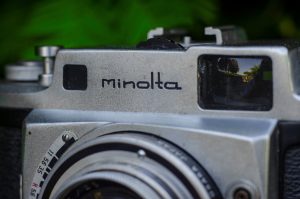 The Minolta A was made by Chiyoda Kogaku Seiko, a camera company based out of Tokyo, Japan during the 20th century. In 1962, Chiyoda Kogaku would change it’s name to match that of it’s most successful product, the Minolta camera and be henceforth known as Minolta Camera K.K.
The Minolta A was made by Chiyoda Kogaku Seiko, a camera company based out of Tokyo, Japan during the 20th century. In 1962, Chiyoda Kogaku would change it’s name to match that of it’s most successful product, the Minolta camera and be henceforth known as Minolta Camera K.K.
Chiyoda Kogaku was one of the first Japanese companies to manufacture their own 35mm and medium format cameras. While many of their earliest models were inspired by existing German designs, Chiyoda made an attempt with each model to improve upon the original in some way. As a result, many early Minolta cameras had unique or innovative features not used by other Japanese companies.
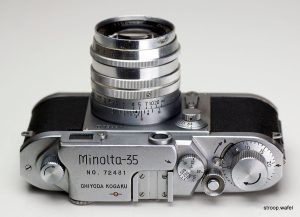
One of their earliest successes was the Minolta-35, a 35mm rangefinder based off the Leitz Leica III.. The Minolta-35 was produced starting in 1947 and shared many of the Leica’s attributes, including its 39mm screw lens mount. The Minolta-35 was a high end and expensive camera that was well built, but did little to allow Chiyoda Kogaku to stand out in the market.
By the mid 1950s, the company expanded it’s product offerings to less expensive “consumer oriented” 35mm rangefinders. This new line of cameras would be called the Minolta A-series, named after the first model, the Minolta A from 1955.

There were at least 3 variations of the Minolta A, mine being the second variant. The differences between the three are mostly in the shutter. The earliest version, and the most rare, had a simple Konan 2-blade shutter with a range of shutter speeds from 1/2 to 1/200. The Konan equipped Minolta A cameras were the only ones that say “Chiyoda Kogaku” on the front face of the shutter. This model also omitted the setting lever on the side of the shutter near the 7 o’clock position which appears on both the later variants. This version also had a rewind knob with horizontal grooves on it. On all later versions, these grooves were vertical.
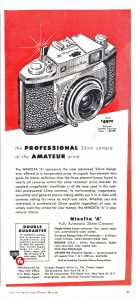
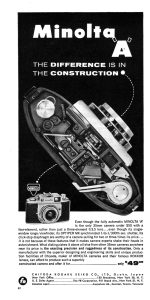
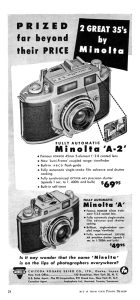 In both the second and third variants, the range of shutter speeds increased to include both 1 second and 1/300 seconds. The difference being that the second version had an Optiper MX shutter and featured a manually setting lever for M-flash synchronization on the side of the shutter. The third variant came with a Citizen MV shutter that replaced the M-sync lever with a self timer (indicated by the letter “V”).
In both the second and third variants, the range of shutter speeds increased to include both 1 second and 1/300 seconds. The difference being that the second version had an Optiper MX shutter and featured a manually setting lever for M-flash synchronization on the side of the shutter. The third variant came with a Citizen MV shutter that replaced the M-sync lever with a self timer (indicated by the letter “V”).
It seems that no matter the variant of the Minolta A, they all sold for $49.95 which is about $450 today. Each of the three ads to the left are from various issues of Modern Photography between 1956 and 1957. Each of the ads boast the value and good construction of the Minolta A. In one, you see a comparison between the A and A-2 models which were sold concurrently.
I could not find any indicator of sales figures for the A or any model in the A-series for that matter, but I have to imagine they were popular. Whether you went with the A or A-2, you got quite a feature loaded camera as in 1955, for $50 you were usually limited to cameras with 3 element lenses, smaller viewfinders, and sometimes even split image rangefinders. Even by the mid 1950s, Chiyoda Kogaku had already developed a reputation for Minolta cameras as being high quality models capable of excellent results.
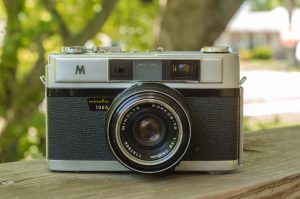
The A-series would go on with more traditionally designed models like the A3 and A5 from 1959 and 1960 respectively. These cameras returned to a more standard front facing shutter, with a more traditional rectangular shaped body. But like the Minolta A, the A3 and A5 models boasted an excellent feature set for the price.
Today, with the exception of the Super-A, the A-series isn’t highly sought after, mainly because these were always budget cameras. For as good as they were at the time, they weren’t any better than many of the huge number of Japanese competitors that were available at the same time. This can work in a collector’s favor as no matter how budget a particular Minolta model might be, they almost always had state of the art Rokkor lenses which were consistently up to the highest quality standards and were capable of excellent images. Whether you’re talking about the 4 element f/3.5 lens in the Minolta A, the 5-element f/2.8 in the A-2, or the 6-element f/2.8 in the Auto-Wide, you are sure to have a highly capable camera.
Repairs
This Minolta came to me in pretty rough shape. I noticed that although the shutter fired at speeds 1/25 and up, at speeds 1/10 and below, they all sounded the same as 1/25. I’ve encountered this before with some Compur shutters that had become sticky, so perhaps the Optiper shutter that came in this camera had the same flaw.
All it took was a quick search for some repair info online and I came across Daniel Mitchell’s site which has some pretty in depth instructions for taking apart the Minolta A. Unfortunately, it seems Minolta took a unique approach with this camera and installed the shutter backwards into the camera. This is why the shutter speed selector is where it is. That black wheel is connected via a gear to the shutter speed ring that typically goes around the perimeter of a typical leaf shutter. If you could imagine a Compur or Prontor shutter and then insert it backwards into the body of a camera, the speed selector is immediately below the Minolta A’s speed wheel.

I saw all I needed to see to determine this wasn’t a camera I wanted to mess with. In a last ditch effort, I liberally doused the shutter speed wheel with some lighter fluid in the hope that it would get somewhere in the shutter and free up whatever was causing the slow speeds not to work. Although I have managed to free up quite a number of cameras with lighter fluid, this time it was not meant to be as the slow speeds remained inoperable. I let the camera dry, wiped it down, and then left it alone. At whatever time I would shoot this camera, I’d just be sure to never try any of the slow speeds.
If you came here hoping to find some detailed info on how to repair a Minolta A, I only leave with you the advice that it’s not really worth it, especially if yours is like mine where some of the speeds work. Just leave it alone, unless you are really adventurous.
It would seem the backwards shutter idea was something Minolta used on quite a number of it’s 50s and early 60s rangefinders as the Minolta A-2, Super A, and Auto-Wide all had shutters installed the same way.
My Thoughts
Chiyoda Kogaku’s first attempt at a fixed lens rangefinder for the consumer market was a pretty good one. The Minolta A would go on to launch a line of A-series cameras that would remain in production for 15 years before transitioning into the Hi-Matic series.
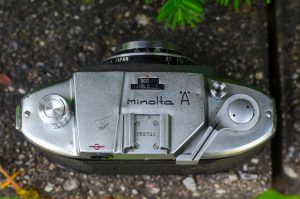
The Minolta A is a handsome camera that sported a variety of higher end features for the price when it was first released in 1955. The first time I saw one, I saw it head on and was impressed with it’s looks. When I finally got a hold of one though, I found it’s dimensions to be rather peculiar. For one, the camera is extremely thick front to back, and it has a couple of ergonomic oddities such as an abnormally long wind lever and a shutter speed selector placed prominently on the top of the camera. Despite it’s odd dimensions, the camera weighs a reasonable 578 grams without film loaded. In a review in the August 1955 issue of Modern Photography, writer Herbert Keppler kindly described the design as “distinct”, but that it wouldn’t win any design awards.
I would later learn that the thick shape of the body and strange location for the shutter speed selector was a side effect of the backwards shutter that faces inwards to the body, but it’s something that will constantly remind you each time you pick up the camera.
Other than the thickness however, the rest of the camera works as you’d expect. The threaded shutter release is right where you’d expect it to be and is easily located with your right index finger. The coincident image rangefinder is bright and easy to use, especially when compared to many mid-1950s rangefinders like the Argus C3 and Bolsey B2 who still used a split image rangefinder.
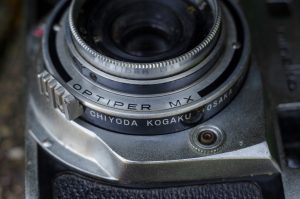
As a result of the backwards shutter, the focus and iris controls are backwards as well. Aperture sizes are changed by rotating the ring around the front lens element where you might expect to find focus control on many cameras. The aperture ring has click stops at each position from f/3.5 to f/22. Focus is easily changed via a large handle that connects to a ring nearest the body of the camera. Although I found the position of the focus handle to be very easy to locate with the camera to your eye, I found that I often would change the aperture size while focusing the camera, and vice versa. Changing aperture sizes either required two hands to stabilize the focus, or just accept that the focus would change as you picked a new f/stop, and have to refocus later. This wasn’t a huge deal, but a minor annoyance.
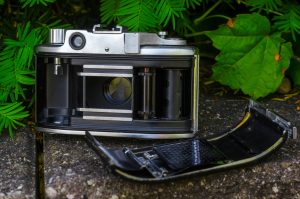
Loading film into the Minolta A is only unique in that the entire back of the camera comes off. There is no hinge like you would expect to see on later cameras. There is a sliding latch on the right side of the camera, but upon releasing the latch, the entire back comes off, so be careful not to let it fall! Film loads left to right and you must pull up on the rewind knob to get the fork out of the way. Once you have a new roll of film in the camera, thread the leader onto the take up spool like most other 35mm cameras. The takeup spool rotates counterclockwise which means the film will start advancing as soon as you have it attached to the spool.
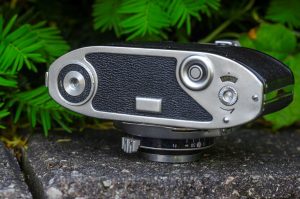
On the bottom of the camera you have the tripod mount, rewind release button and manually resetting frame counter. The frame counter counts up, like most cameras not made by Kodak or Voigtlander.
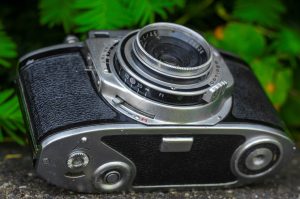
Of all the features on the Minolta A, the strangest feature is the “M-sync” cocking lever, which is located near the 7 o’clock position of the side of the shutter. There are three variants for the Minolta A, and this lever only exists on the second variant. On the third variant, this lever is still there, except it is the self-timer. The Optiper shutter on this camera requires a separate cocking motion for M flash sync. I will likely never attempt using a flash on this camera, so its not something I’ll ever use, but the first time I handled this camera, I had to look up it’s function in the camera’s manual as I had never seen another camera with this “feature” before.
With some cameras, there is an inexplicable level of joy when handling them. Sometimes a camera just speaks to you for one reason or another. The Minolta A is not one of those cameras. I wouldn’t go as far as to say there’s anything necessarily bad about the camera, I just got this real ho-hum feeling while shooting it. I did manage to get through the first roll of film rather quickly, but it almost seemed like a chore to remember to pick it up.
Minolta clearly wanted to try something different with this camera and I applaud their efforts to include some pretty modern features in a camera that had a list price of $49.99 back then, but it came with compromises in size and handling. Again, nothing that I hated, but it was enough to prevent me from getting any warm and fuzzies about it.
As with all cameras, they are designed to make images and if this camera made some pretty good images, perhaps I could look past these shortcomings. Perhaps indeed…
My Results
I split a roll of Kentmere 100 film with my Nikon S2 with the intent of taking 18 shots with this camera and another 18 with the Nikon. I didn’t have any expectation that the Minolta would ever compare to the Nikon, I just had two cameras that I wanted to get some quick shots with and since I now develop my own black and white film, it was an easy way to check two cameras using only a single roll of film.
With the roll loaded, I went through the first 18 shots entirely on my route home from work over the course of two days.
I should have known better. While I could never describe the user experience as memorable, I should know by now that any time you see a lens with the name “Rokkor” on it, that you have something special.
Special indeed. These images, which I’ll admit to are less than inspired were shot with little thought on my way to and from work, yet most of them turned out great! There is a clear light leak in the bottom left side of a couple of images that I would need to address if I were to take this camera out again, but beyond that, the 4-element Rokkor 3.5 lens delivered superb results! Sharpness is excellent in the middle and pretty good near the corners.

Although I didn’t intentionally shoot any “bokeh-worthy” photos, I do see a little bit of football shaped orbs near the corners in a couple of the images. The very first image of the stone tree sculpture (which is actually a headstone) shows it in the corners.
All of the images, even those closeup are perfectly in focus suggesting the rangefinder is accurate on the camera, despite no adjustment from me. The image of the barn window shows a beautiful texture and sharp details in the aged wood.
Combined with the fresh Kentmere 100 film and Sunny 16, I shot almost all of these photos with either a 1/50 or 1/100 shutter speed and I’d say exposure is spot on suggesting the shutter is still firing at the correct speeds.
This is one of those cameras that required me to see my results before I could accurately reflect on my opinion of it. I won’t say that excellent results can overcome an uninteresting shooting experience, it certainly bodes well for repeat uses. I have always known Minolta to be a maker of fine cameras and the Rokkor lenses that they usually come with are some of the best out there, but it’s refreshing to know that even their entry level models were not stripped of quality optics.
The Minolta A is a camera that has a controversial design, some might hate it, some might love it. I’m somewhere in between. But I would be shocked to hear of anyone who criticizes it’s merits as a camera after seeing what it’s capable of. These cameras are pretty common and almost always sell for very little, so if you have an opportunity to pick one up, I strongly recommend it!
My Final WordHow these ratings work |
The Minolta A was Minolta’s first attempt at an inexpensive fixed lens 35mm rangefinder, and although it has a few peculiar design elements, the camera works really well. Despite it’s age, the shutter speeds were accurate, the rangefinder was spot on, and the Rokkor 3.5 lens delivered incredible shots. I was very impressed with my first roll through this camera, and although I didn’t love the shooting experience, this is a camera I would likely want to shoot again someday. Considering how cheap you can pick these up online, this is an easy camera to recommend. | ||||||
| Images | Handling | Features | Viewfinder | Feel & Beauty | History | Age | |
| 2 | 0 | 1 | 1 | 1 | 1 | 30% | |
| Bonus | none | ||||||
| Final Score | 7.8 | ||||||
Additional Resources
http://camera-wiki.org/wiki/Minolta_A
http://pheugo.com/cameras/index.php?page=minoltaa
http://www.cjs-classic-cameras.co.uk/minolta/minolta.html
http://www.collection-appareils.fr/x/html/page_standard.php?id_appareil=11538
https://www.flickr.com/photos/38552878@N02/albums/72157657724633535/with/20671116379/

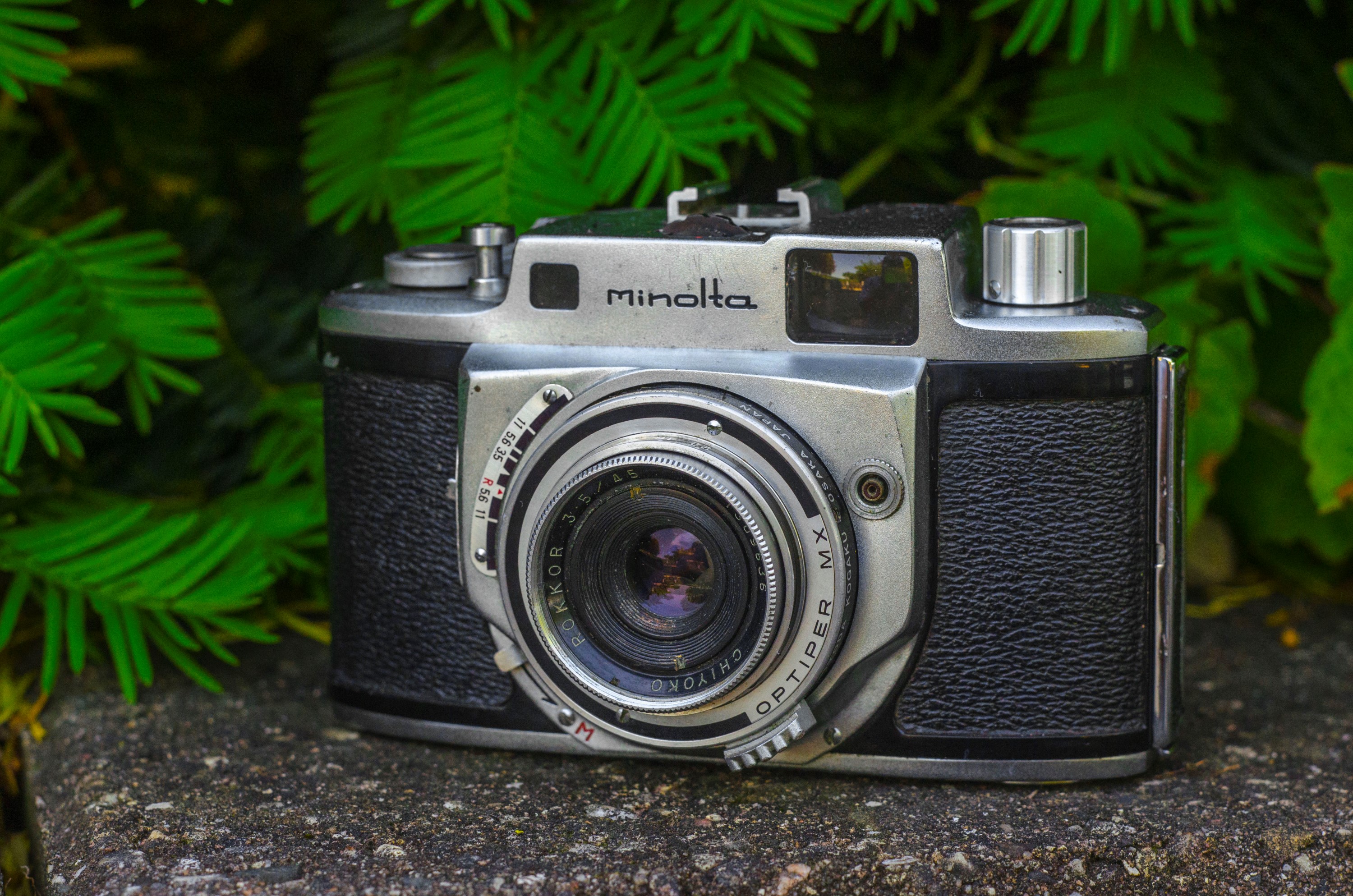

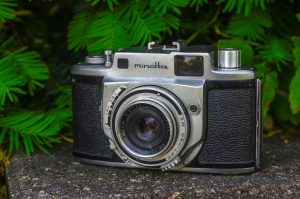








Mike, an insightful review of a fascinating early Minolta. I’d not come across mention of this one before. I was so hooked, I sourced one on ebay.uk for £20, say $25. S/n. 143052. It came with a half case, very grimy UV filter, and a little leather accessory case and which I’d assumed would contain a lens hood. Well it did, but not for this camera. It’s a Rollei Bayonet 1! I have four TLR’s I can use it on, and going by current prices, I got the Minolta virtually free. Serendipity, indeed.
The filter had done its job; once removed the optics looked pristine, no haze or fungus etc. The shutter has problems with 1 sec and 1/2 sec, 1/5 is temperamental, but B and 1/10 to 1/300 seem fine. Once all the detritus of age and use had been cleaned up, it looks in pretty good nick. The v/f and r/f are clear and the r/f seems accurate over a range of distances tested in that the distance measured agrees with the distance scale on the lens. The only known fault at this stage is the the lower M lever does not lock into position. And finding non-standard screws in the base plate betrays that the camera has been “messed” with at some time. But mechanically, at least, all appears well. Wind on and focusing are smooth and the apertures still have firm click stops.
Ergonomically, not the best, I’m not keen at all on the speed setting wheel, but as you say, it’s all in the lens.
I am always happy to spend other people’s money for them! The Minolta A certainly is a strange camera. I understand that because the shutter was mounted backwards, the top shutter speed dial became a necessity, but I’ll still never understand why Chiyoda Kogaku decided to do it that way. The entire Minolta A-series up to the A3 was like that. I am sure though that once you see the images you make with the Rokkor lens, you’ll forget all about the goofy layout.
Great article Mike! I was looking at a couple of Minolta A’s on eBay. Some were actually going for more than you’d think. Anyway, I obtained this one for $10 in “as-is” condition. Seller was not a vintage camera buff, by their admission. When delivered, I tried it out. At first, shutter speeds 1/25 and slower were too fast, but repeat firings freed up all the speeds, down to 1 sec and B! So, for very little money, I got a very clean, fully functioning old Minolta rangefinder. My only complaint: that shutter speed wheel. Located top-center, with no detents between speeds, it’s too easy to change speeds, if you’re not careful!
My father got me a Minolta A when I was about 10 years old (I’m 65 now); it was my first camera.
The camera needs repair so I got another identical (they’re both the second version) “A” on eBay with my high probability that it can be used as a source of parts when repairing the first one. I’ve never repaired a camera and, even if I could repair this one, I don’t want to take the immense amount of time it would take me.
Does anyone know of a camera-repair person who can repair a Minolta A? If so, thanks in advance.
David
Minneapolis, Minnesota, USA
David, I would reach out to Frank Marshman who I’ve referred many people to for repairs. I will send you his email address privately as I am sure he can help you.
Mike, great post! Question: the rangefinder in my Minolta A does not adjust at all with focus. Any idea how to do the adjustment? I cannot find any instructions online.
Jerome, as I recall, there is a pin that goes from the lens helix to the rangefinder beneath the top plate. Most likely the original lube that was out there 60 years ago has dried up and needs to be cleaned. Taking the top plate off the Minolta A isn’t the easiest to do, but if you can get it off, it should be pretty easy to figure out from there. You can use either naphtha oil or spray electric contact cleaner to clean it. Good luck!